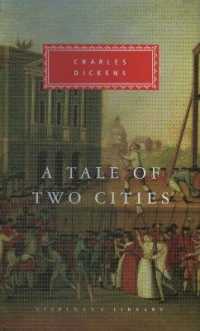- ホーム
- > 洋書
- > 英文書
- > History / World
Full Description
The Neolithic Cemetery at Tell el-Kerkh is the second volume of the final reports on the excavations at Tell el-Kerkh, northwest Syria. The 12-year field campaigns at Tell el-Kerkh yielded several unexpected archaeological findings. The existence of the oldest cultural deposits from the early Pre-Pottery Neolithic B period (c. 8700-8300 BC) in northwestern Syria was revealed. The investigations also revealed that several large and complex societies had existed from the late Pre-Pottery Neolithic B to the middle Pottery Neolithic periods (c. 7600-6000 BC). One of the most conspicuous findings of the excavations at Tell el-Kerkh was the discovery of a Pottery Neolithic cemetery dating between c. 6400 and 6100 BC, which makes it one of the oldest outdoor communal cemeteries in West Asia. This book focuses specifically on this cemetery. It reports the discovery of over 240 burials and discusses the process of the formation and development of the cemetery. Initially used for traditional house burials in a corner of the settlement, the cemetery eventually became a graveyard that was physically separated from the residential buildings and consisted only of graves. In other words, burials that were deeply related to each house developed into an outdoor communal cemetery of the settlement. The Kerkh Neolithic cemetery was a precursor to the wider development of communal cemeteries in West Asia, and its investigation provides us with a deeper understanding of Neolithic society in West Asia.
Contents
Chapter 1: Introduction - Akira Tsuneki ;
Chapter 2: Geological Conditions of Tell el-Kerkh - Ken-ichiro Hisada ;
Chapter 3: The Tell el-Kerkh Site and Stratigraphy - Akira Tsuneki ;
Chapter 4: Burial Types and the Transition of Kerkh Cemetery - Sari Jammo ;
Chapter 5: Burial Catalogue of Kerkh Cemetery - Akira Tsuneki, Naoko Hironaga, Sari Jammo, Yuko Miyauchi and Yuki Tatsumi ;
Chapter 6: The Human Remains of Tell el-Kerkh - Sean P. Dougherty ;
Chapter 7: Radiocarbon Dating at Tell el-Kerkh - Yu Itahashi and Minoru Yoneda ;
Chapter 8 (Discussion 1): Body Transformation: Skull Retrieval, Manipulation and Circulation of Human Remains at Kerkh Cemetery - Sari Jammo ;
Chapter 9 (Discussion 2): The Meaning of Cremation - Naoko Hironaga ;
Chapter 10 (Discussion 3): Stable Isotope Analyses of Human and Animal Bones at Tell el-Kerkh - Yu Itahashi and Minoru Yoneda ;
Chapter 11: Conclusion - Akira Tsuneki ;
Appendix: Neolithic Burials Outside of the Cemetery - Naoko Hironaga ;
References ;
Arabic Summary







